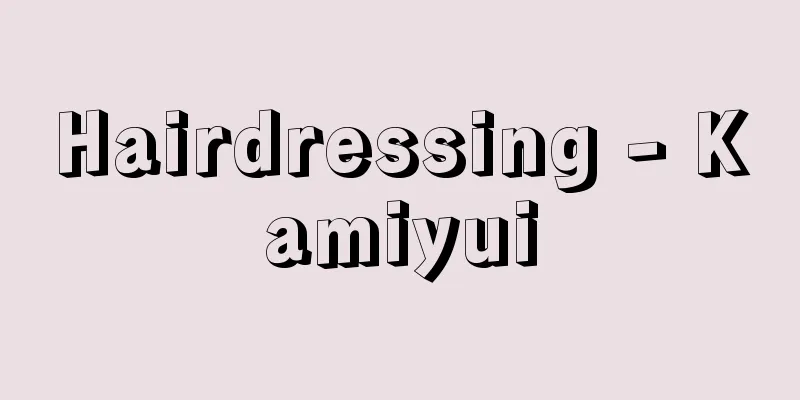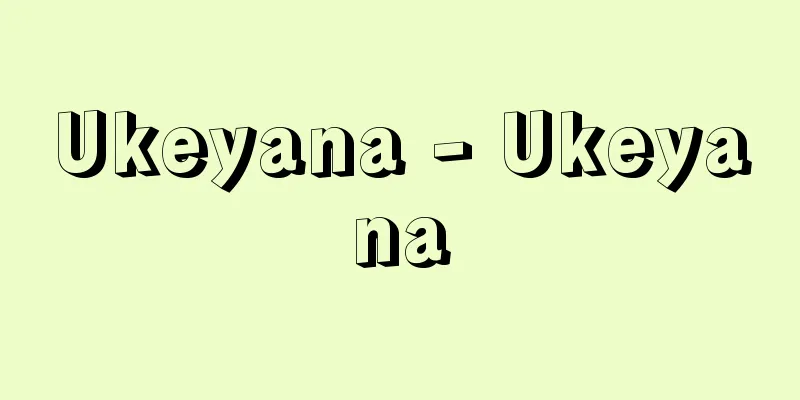Hairdressing - Kamiyui

|
A craftsman who ties hair. In the Heian and Kamakura periods, men only needed simple hair styling in order to wear eboshi hats, but in the late Muromachi period, rotou and sakayaki styles became common, and as a result, people who specialized in hair styling and shave tsukuyaki appeared. They were also called issenzori or issenshoku, but this name is thought to come from the early days of the hairdressing fee. In addition, because they operated from simple temporary shops (toko) that could be folded up, the shops were called kamiyui-doko or tokoya. In the early modern period, kamiyui mainly existed as town-hachi or village-hachi. In the three capitals (Edo, Osaka, and Kyoto), there were dedoko, which kept beds at bridgeheads and crossroads, and uchidoko, which stayed within guardhouses and meeting halls (there were also uchidoko, which visited customers with their tools), but both were owned and managed by the town, and were, so to speak, employed to fulfill a specific function in the local community, just as in Edo, dokos stayed at guardhouses and acted as guards. In addition, hairdressers were given other duties, such as watching over bridges and rushing to government offices in the event of fire. Furthermore, hairdressers' beds were also town social gathering places, as depicted in Ukiyodoko and Edo Hanjo-ki. Female hairdressers who did women's hair appeared late, and were banned, as women, with the exception of a few women such as geisha, did their own hair, but they were openly operating at the end of the Edo period. → Barbershops → Related topic: Barbershops Source : Heibonsha Encyclopedia About MyPedia Information |
|
髪を結う職人。平安・鎌倉時代には男性は烏帽子(えぼし)をかぶるために簡単な結髪ですんでいたが,室町後期には露頭(ろとう)や月代(さかやき)が一般的になり,そのため,結髪や月代そりを職業とする者が現れた。別に一銭剃(いっせんぞり),一銭職とも呼ばれたが,これは初期の髪結賃からの呼称とされる。また取りたたむことのできるような簡略な仮店(〈床〉)で営業したことから,その店は髪結床(かみゆいどこ),〈とこや〉と呼ばれた。近世には髪結は主に〈町(ちょう)抱え〉〈村抱え〉の形で存在していた。三都(江戸・大坂・京都)では髪結床は,橋詰,辻などに床をかまえる出床(でどこ),番所や会所の内にもうける内床があるが(他に道具をもって顧客をまわる髪結があった),ともに町の所有,管理下におかれており,江戸で番所に床をもうけて番役を代行したように,地域共同体の特定機能を果たすように,いわば雇われていた。そのほか髪結には,橋の見張番,火事の際に役所などに駆け付けることなどの〈役〉が課されていた。さらに髪結床は,《浮世床》や《江戸繁昌記》に描かれるように町の社交場でもあった。なお,女の髪を結う女髪結は,芸妓など一部を除いて女性は自ら結ったことから,現れたのは遅く,禁止されるなどしたが,幕末には公然と営業していた。→理髪店 →関連項目床屋 出典 株式会社平凡社百科事典マイペディアについて 情報 |
<<: Kamiyubetsu [town] - Kamiyubetsu
Recommend
Isokani deception - Isokani deception
A crab-shaped marine animal belonging to the fami...
Kanpou
Date of birth and death unknown. A historian of t...
Semi-synthetic fiber - Semi-synthetic fiber
A synthetic fiber made by chemically reacting natu...
binding power
The content of a judgment made by a court in the ...
Wingworm - Wingworm
A general term for Chaetopterus variopedatus, a m...
Kawazu [town] - Kawazu
A town in the Kawazu River basin in the eastern pa...
Renormalization theory - Renormalization theory
In quantum field theory, the incorporation of eff...
Ischnura asiatica (English spelling) Ischnura asiatica
…The yellow dragonfly Ceriagrion melanurum (illus...
Gleim, JWL (English name) GleimJWL
...Its influence extends widely from Goethe to th...
Gallé - Émile Gallé
A glass artist and luxury furniture maker who rep...
Frank Sinatra
American pop singer and film actor. Born in New J...
Rain gear - Amagu
A general term for clothing and tools used in the...
dvorets kul'tury (English spelling) dvoretskultury
…[Tokihiko Mori] Similar facilities were also fou...
Inside the storehouse - Kuranonaka
A short story by Koji Uno. It was published in the...
Mentor method
...In addition to the solanaceae, the United Stat...


![Fukuno [town] - Fukuno](/upload/images/67ccb0af0e9dc.webp)

![Ave Maria (English spelling) Ave Maria [Latin]](/upload/images/67cad81b2376e.webp)




